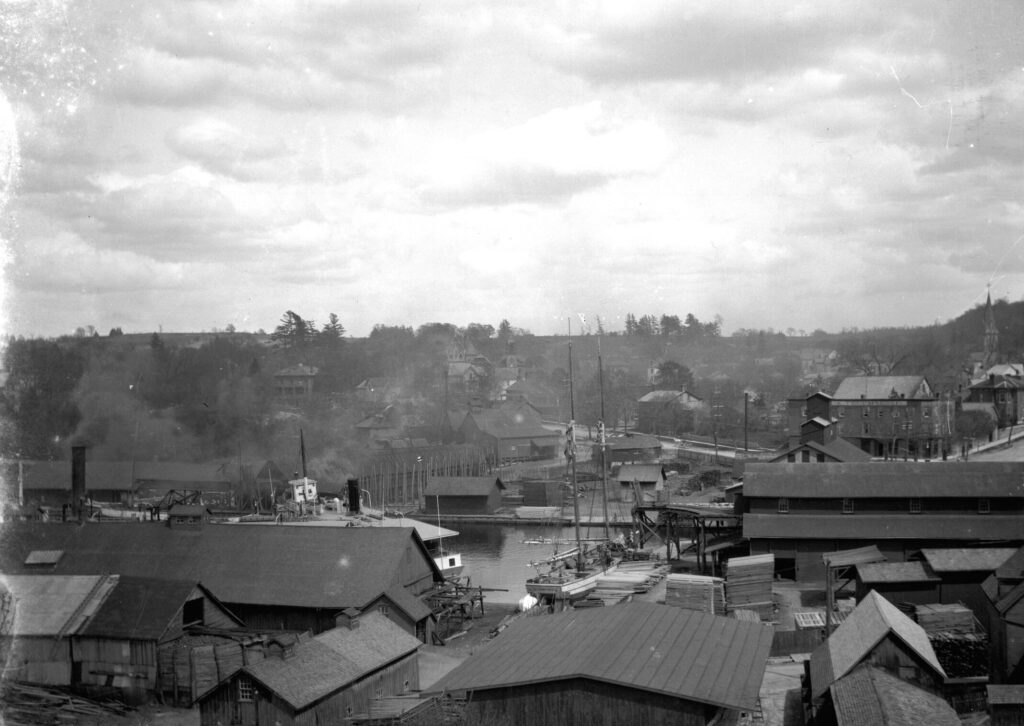
I was on a tour boat in Picton Bay. Early summer 2020. Sunset.
“I hate it when they do that,” the skipper said, pointing at the water. What, I wondered.
“Empty their ballast tanks coming into the port.”
A track about as wide as a double lane highway sat on the surface of the water. Lines clearly delineated old water from new like a strange, aquatic Persian rug on a dark blue hardwood floor. Water, from the port of Toronto, or Hamilton, or maybe even Montreal had been released just west of Glenora.
The ballast trail was within a few hundred metres of the Chimney Point intake pipe. The offending laker sat looking smug in the dying light at the port.
“They should be doing that before coming around the gap,” the captain said. “I don’t know about you, but I don’t like to drink water straight from Hamilton harbour.”
Consider this turn-of-the-century picture of Picton Harbour. Back in the Barley Days and later when the County was Canada’s fruit basket, Picton Bay hosted a level of commercial activity to rival anything outside Toronto or Montreal. So what was leaking from the warehouses lining the shore or from boats sitting in the Bay? What heavy metals and coal were spilled into the waters while boats were unloaded?
Sediment tests completed in 2011 show levels of heavy metals and lead that exceed federal guidelines throughout the three Intake Protection Zones for Picton’s drinking water.
Those threats are a hangover from the past. Ecological time bombs with long enough fuses that those who currently drink the water don’t need to worry. Yet.
Picton’s Water Treatment Plant was built at Chimney Point in 1928 and is scheduled to reach end-of-life in 2031. At one point, the plant had a rated capacity of 10,400m3/day. Now, however, a recent stress test topped out at 6,000m3/day. The plant is so archaic, a municipal source tells me, the County is at the point of machining replacement parts as most are no longer available.
The proposed solution is a Regional Water Plant in Wellington, priced at an astonishing $192 million. Other options? Well, the ballpark estimate in the Picton Master Servicing Plan for a new Picton plant is about $80 million: $23 million for a new intake, $50 for the plant, and $3 million for a new water main to connect it all.
That price tag is for Picton and Bloomfield alone. A Wellington plant to meet current and forecasted needs would also have to be built. Building two plants would cost $5-$16 million more than building just one. The County estimates savings of $250,000 every year on maintenance and servicing in the Regional approach.
Nor does building two plants solve the issue of sourcing drinking water from Picton Bay. Intakes in shallower water and closer to shore, like Picton’s, are in “inland lake systems,” far more vulnerable than intakes far offshore, like Wellington’s, a “Great Lake system.” The Wellington intake is more than 1 km offshore in water that is almost 10 metres deep.

Picton Bay’s intake is 91m offshore in water that is 3.3m deep. Further, this inland lake sits in water with no natural flushing, a history of a wide array of serious toxins in the sediment, and close to an unsupervised and expanding industrial zone which faces container shipping as well as increased cargo shipping alongside unsupervised, active quarrying with runoff just next to the lake. Heidelberg Materials is now burning large amounts of alternative low carbon fuels.
Picton Bay is broken down into three Intake Protection Zones. On a scale of 1-10, with 10 representing the highest vulnerability, the threat matrix for zones 1 and 2 is 10 and 9, respectively. IPZ 3 contains Picton Terminals and is adjacent to Heidelberg Materials. This third zone is broken down into two portions that register 8 and 6. In total, 319 threats have been identified in Picton’s three Intake Protection Zones, including 74 “significant” threats.
There are no threats to Wellington’s drinking water, whose IPZs score a 5 and a 3.5.
“The Picton Drinking Water System is considered one of the most vulnerable in the Quinte Region due to the location of its intake, combined with the surrounding land use and geological/hydrogeological features,” says County spokesperson Mark Kerr.
Currently, the County uses a number of chemicals to treat Picton Bay’s water. Part of that is the age of the system, but poor results from raw water samples drive most of it. In Wellington, just two chemicals treat clean water drawn far out in the lake.
“Generally speaking, the quality and characteristics of the raw water coming from Lake Ontario make the treatment process much simpler,” added Mr. Kerr. “At the new Wellington water treatment plant we anticipate being able to use membrane filtration, which will [further] reduce the amount of chemicals we use compared to treating water drawn from Picton Bay.”
When it comes to the water my family and I drink, my concern isn’t higher water bills. It is the health of my children, my grandchildren and the other 7,000 users of the Picton drinking water system.
If Council waffles on a new regional treatment plant in Wellington, sourcing and treating water from busy Picton Bay will become an environmental nightmare. It’s just a matter of time. Ballast, sediment disruption, and a genuine risk of spills from cargo and container ships at Picton Terminals and Heidelberg Cement. Leachate from the dump and the cemeteries into Marsh Creek and into the Bay. Algae blooms. Invasive species.
Even the spring melt, when sodium chloride runoff from winter road maintenance flows into the Bay through the storm sewer system poses a threat.
With dangers from the past, present and future on all sides in Picton Bay, the obvious move is to source drinking water from Lake Ontario.
See it in the newspaper